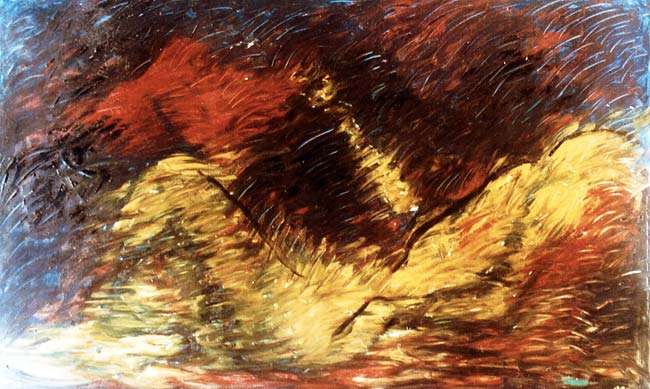José Cláudio
Plínio Palhano and the expressionism fashion
I am of opinion that Plínio Palhano should exhibit some smaller and older paintings to show that the actual and bigger ones (2 x 1,23 m) are not an outcome of a crossover enthusiasm for the fashionable painting, transvanguard or any other name it may have, which hit the Brazilian painting since two or three years ago, mainly among youngsters like Jorge Guinle. That does not happen to Plínio Palhano, who has his own roots for a long time - if it is possible to say "for a long time" about a painter who is just thirty years old.
They will argue that, from those former works, the painter could have followed other trends - inasmuch as from any work any way may be followed -, but what matters here is that any other choice would be followed by disorder, irresponsibility or opposition, however the actual pictures reveal the painter´s most radical commitment to himself, as well as to his dramatic side influenced by Rembrandt, Van Gogh and Iberê Camargo who are always present in his personality of painter.
I do not dismiss a possible agreement with the aforementioned fashionable painting, fashion maybe on the wane - as in Brazil the foreign echo is all-too-often a hint that the party is over -, but to say that about Plínio is as unfair as to say it about others who have sought the same ideals when the fashion, or fashions, was quite another, such as pop art or conceptual art, and painting was regarded as alienation.
This exception made, we might ask: what´s wrong with following the fashion? Dürer, Titian, Rubens followed the fashion. Dürer fought to the bitter end to get from a certain Italian painter a supposed golden rule to be used in the pictures whose owner, he thought, was a certain painter, and much of his work is motivated by his crazy search for the key to this geometry which he supposed to have been stolen from the Greeks by the Italians. Finally, such stories are brought to mind as curiosities, the work is what remains.
Aside from the present-day fashion, there are old fashions recovered by painters and musicians, in addition to the fashion of not to be in fashion, which may be regarded as the essence of the fashion itself. But there is a bedrock constituency in art that should not be confounded with it. It looks like clothes: they may stimulate some gestures and poses, but do not let us forget that there is a body concealed within.
This body is Plínio´s painting, transient like our own flesh and enduring like a statement on the lived moment he gives us in the shape of an open work in which concerns for perfection, if there is any, lead to the brushstrokes and palette knife strokes captured at the surgical instant of which the outcome was a painstaking delivery.
Back to FLOWERS OF FIRE




